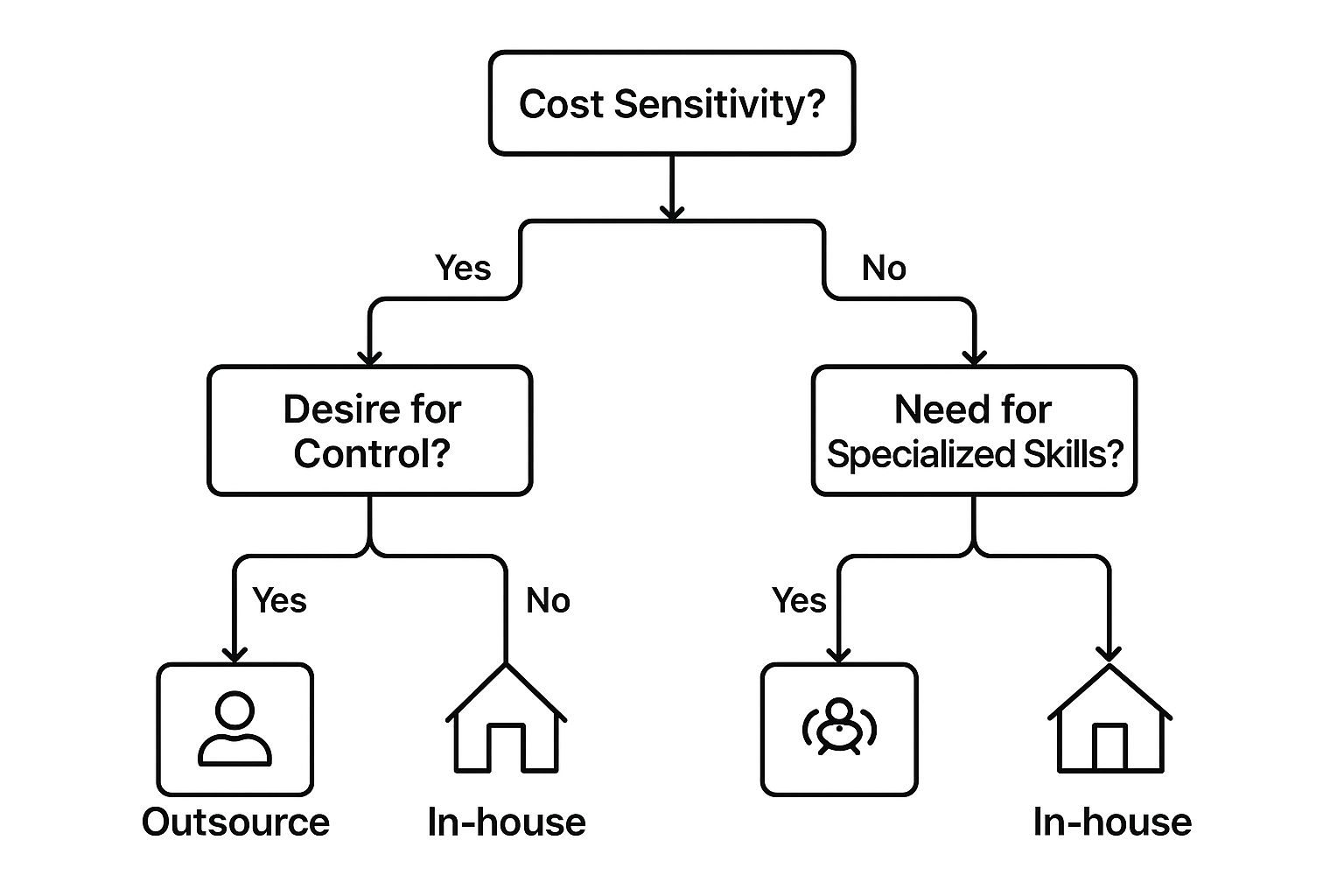Deciding between building your own team or hiring an outside partner is one of those make-or-break moments for a business. The core of the in-house vs. outsourcing debate boils down to a fundamental trade-off: outsourcing often brings specialized talent and cost savings, while an in-house team gives you direct control and a stronger cultural connection.
There’s no single right answer here. The best path depends entirely on your specific goals—are you prioritizing immediate efficiency, deep-seated expertise, or the ability to scale on a dime? This guide is designed to move past the generic pros and cons and give you a real framework for making that call.
The Core Decision: Outsourcing vs. In-House
Outsourcing isn't a niche strategy anymore; it’s a massive slice of the global economy. The business process outsourcing (BPO) market is expected to hit a staggering $525 billion by 2030. It’s no surprise when you see that 92% of G2000 companies use some form of IT outsourcing to stay competitive.
While IT (54%), finance (44%), and payroll (32%) are commonly handed off to specialists, this trend highlights a broader business truth: companies are outsourcing to cut costs and sharpen their focus on what they do best. You can dig into more of these trends and stats over at Exploding Topics.
Quick Comparison: Key Differences at a Glance
Before we get into the nitty-gritty, let's start with a high-level snapshot. This table cuts straight to the chase, outlining the fundamental differences you'll encounter when choosing your path.
| Factor | In-House Team | Outsourcing Partner |
|---|---|---|
| Cost Structure | High fixed costs (salaries, benefits, overhead) | Variable, contract-based costs |
| Control | Direct, hands-on management and oversight | Indirect management through a vendor relationship |
| Expertise | Developed over time, limited to hires | Immediate access to specialized, experienced talent |
| Scalability | Slow; requires hiring and training | Rapid; can scale up or down on demand |
| Speed to Market | Slower due to recruitment and onboarding | Faster, as teams and infrastructure are in place |
| Cultural Fit | Deeply integrated with company culture | Operates externally with different cultural norms |
Think of this table as the framing for your decision. Each of these points represents a trade-off with real-world consequences. In the sections that follow, we'll dive deep into what these factors—from financial realities to day-to-day control—actually mean for your business. By the end, you'll have a clear lens to see which model truly aligns with your long-term vision.
A Realistic Financial Comparison

When you're weighing an in-house team against outsourcing, it's easy to get tunnel vision. You see a vendor's quote on one side and an employee's salary on the other. But that’s a dangerously simplistic view. To get the real picture, you have to dig into the Total Cost of Ownership (TCO) for each option, because the hidden expenses are what will really make or break your budget.
For an in-house team, the salary is just the tip of the iceberg. The full financial weight includes a long list of costs that add up faster than you’d think.
The Hidden Costs of an In-House Team
Building your own team means you're not just funding payroll. You're essentially launching a mini-business within your business, and it needs its own infrastructure, tools, and support.
Think about all the cash you have to lay out:
- Recruitment and Onboarding: This isn’t free. You’re paying for job postings, recruiter fees, background checks, and—most importantly—your team’s valuable time spent sifting through resumes, interviewing, and training.
- Salaries and Benefits: The sticker price of a salary is misleading. You need to add health insurance, retirement contributions, payroll taxes, and paid time off. All in, that can easily tack on an extra 25-40% to their compensation.
- Infrastructure and Tools: This covers everything from the desk they sit at to the software on their computer. For product imaging, we're talking about expensive cameras, specialized lighting rigs, and pricey editing software licenses that need constant updates.
Here’s the rule of thumb I always use: the true cost of an in-house employee is often 1.5x to 2.5x their base salary once you factor everything in. Forgetting that simple math is one of the biggest mistakes companies make.
The Financials of an Outsourcing Partner
Outsourcing looks a lot cleaner on paper. You get a contract with a predictable, fixed cost, which makes budgeting feel much simpler. But don't be fooled—there are hidden costs on this side of the fence, too.
You'll want to watch out for a few things:
- Vendor Management: Someone on your team still has to manage the relationship. Time spent on calls, in meetings, writing briefs, and reviewing work is a real, tangible cost.
- One-Time Setup Fees: Many agencies charge an initial fee to get started, whether it's for discovery sessions, project setup, or just getting their team up to speed on your brand.
- Scope Creep: This is the big one. If your needs change or you ask for more than what's in the original agreement, expect the bill to grow. A rock-solid contract is your best defense here.
At the end of the day, cost efficiency is still one of the biggest reasons people outsource. You sidestep the heavy, ongoing expenses of salaries, benefits, and training. Plus, you don't have to pay for office space or thousand-dollar cameras that sit idle half the time.
Ultimately, the choice comes down to ROI. An in-house team is a long-term capital investment that, ideally, builds expertise and institutional knowledge over time. Outsourcing, on the other hand, gives you immediate access to specialized skills and the flexibility to scale up or down as needed, usually for a lower upfront cost.
To get a better handle on the specific numbers, especially for creative work, check out our guide on the https://prodshot.net/cost-of-professional-product-photography. And for a broader perspective, understanding different strategies for reducing operational costs, including outsourcing, can provide the context you need to make the right call.
Comparing Control, Quality, and Expertise

The in-house versus outsourcing debate quickly moves past the numbers on a spreadsheet and gets to the heart of how you run your business. Sure, cost matters. But the real tug-of-war is often between direct control and specialized expertise. This isn't just about who does the work; it's about shaping the quality, culture, and institutional knowledge of your entire operation.
An in-house team gives you something priceless: total control. You’re right there, overseeing every single step from the first brainstorm to the final file delivery. This proximity means you can give immediate feedback, pivot on a dime, and bake your company’s unique quality standards into the process without a single email chain.
This hands-on approach is especially critical for your core business functions or any work that involves proprietary information. When your team shares the same physical or virtual office, they absorb your brand's DNA through osmosis. There's a built-in sense of ownership that's incredibly difficult to replicate with an outside partner.
The Trade-Off: Gaining Expertise
Outsourcing completely flips the script. You give up some of that moment-to-moment control in exchange for instant access to a deep well of specialized talent. A good product imaging partner isn't just a freelancer with a camera; they're a team with battle-tested workflows honed from working with hundreds of different clients and products.
They’ve already made the huge investment in top-tier tech, spent years refining their process, and solved problems you haven’t even thought of yet. This is what they do. Their entire business is built on being the best at this one specific thing.
For a new e-commerce brand that needs to launch with pro-level product photos in a few weeks, building an in-house photography team is a non-starter. Outsourcing plugs you directly into the skills and infrastructure you need to go to market fast, without the agonizing learning curve.
Tapping into that kind of immediate expertise can be a massive shortcut. Instead of spending months trying to recruit, hire, and train a single specialist, you get an entire team of them, practically overnight. This is a huge advantage when speed is critical or you need a very niche skill set that's hard to find on the open market.
Who Owns Quality Control?
The difference between the two models really snaps into focus when you talk about quality. With an in-house team, quality assurance is woven into your company culture and managed through direct oversight.
With an outsourced partner, quality management becomes a game of communication and verification. Success depends entirely on setting up a solid framework from day one:
- Insanely Detailed Briefs: Your project requirements, brand guidelines, and visual “do-and-don’t” examples have to be crystal clear. Leave no room for interpretation.
- Hard-and-Fast KPIs: Get specific. Define your metrics for success, from image resolution and file naming conventions to required turnaround times.
- Frequent Check-Ins: Schedule regular reviews and feedback calls. It’s the best way to catch small misunderstandings before they snowball into big headaches.
Ultimately, the choice comes down to balancing risk. The in-house route is about playing the long game, slowly building deep, proprietary knowledge. Outsourcing is about making a strategic injection of high-level expertise right when and where you need it most. The right move depends on whether your priority is building internal muscle or achieving world-class results now.
How Each Model Impacts Scalability and Speed
In a fast-moving market, being able to adapt is everything. The whole outsourcing vs in-house debate often boils down to one simple question: which model can react fastest to market changes and support sudden growth? Your choice here directly impacts how quickly you can jump on an opportunity or pivot when things don't go as planned.
An outsourced partner gives you almost instant access to a fully built operational machine. This lets you ramp your output up or down with incredible speed, which is a massive advantage for startups, seasonal businesses, or anyone trying to break into a new market.
When your business gets a surprise spike in demand, a good outsourced team can often double its output in just a few days. Trying to do that with an in-house team could take months of recruiting, hiring, and training. By then, the opportunity might be long gone.
This kind of flexibility is a core benefit of outsourcing. Scalability is a huge win—your in-house team has a fixed capacity that costs time and money to expand, but an outsourced team can stretch and shrink to meet whatever demand comes your way. This agility lets your internal staff stay focused on core business goals while the external experts handle the specialized work. You can discover more about how outsourcing powers business growth at Callnovo.com.
In-House Teams and Predictable Growth
While outsourcing is the champion of reactive speed, an in-house team is built for proactive, sustainable growth. Let's be honest, the process is slower. Hiring, onboarding, and truly integrating a new person is a deliberate investment of both time and money.
But that initial slowness pays off big time in the long run. An in-house team builds up a deep well of institutional knowledge. They understand your products, your customers, and your internal quirks on a level an external partner rarely can. This expertise becomes a powerful engine for long-term innovation and stable, predictable growth.
Instead of just reacting to market shifts, a deeply integrated team can help you see them coming.
Comparing Scalability Dynamics:
| Factor | Outsourcing Model | In-House Model |
|---|---|---|
| Speed to Scale Up | Fast. Add resources and capacity almost instantly, based on your contract. | Slow. Tied to recruitment cycles, hiring, and training timelines. |
| Speed to Scale Down | Fast. Reduce scope or end contracts with a clear notice period. | Slow & Costly. Involves tough decisions like layoffs and restructuring. |
| Growth Type | Reactive & Elastic. Perfect for handling volatile demand and rapid market entry. | Proactive & Stable. Best for building long-term, predictable innovation. |
Ultimately, the decision comes down to the rhythm of your business. If you're in a volatile market with sharp peaks and valleys in demand, the elasticity of outsourcing is a clear winner. But if your strategy is all about building a durable competitive edge through proprietary knowledge and steady innovation, investing in your own dedicated team provides a much more solid foundation for that journey.
Making The Right Choice For Your Business

The whole outsourcing vs in house debate isn't just a thought experiment. It's a real-world decision that lives and dies by your specific business context. A choice that puts one company on the fast track could bring another to a screeching halt.
To make the right call, you have to get past the generic pro/con lists and look at your own situation through a sharp, strategic lens. It means taking a hard look at your core operations, security needs, budget realities, and where you want to be in a few years. Only then can you turn the ideas in this guide into a decision that actually fits your company.
A Scenario-Based Decision Framework
Let's ground this in a few real-world examples. It quickly becomes clear how different business situations naturally lean one way or the other.
Scenario 1: The Scrappy Tech Startup
A new tech startup needs to get its Minimum Viable Product (MVP) out the door—yesterday. They're running on a shoestring budget and simply don't have the cash to hire a full-time, expert development team. Speed is everything.
- Recommendation: Outsource.
- Why It Works: Outsourcing gives them instant access to a skilled team without the crushing overhead of salaries, benefits, and recruiting. It flips a huge capital expense into a predictable operational cost, freeing up vital cash for marketing and actually getting users.
Scenario 2: The Enterprise Managing Sensitive Data
A big financial services firm is building a new proprietary trading algorithm. This project is swimming in sensitive customer data and intellectual property that forms the very core of their competitive edge.
- Recommendation: In-house.
- Why It Works: Here, the need for absolute control over security, data privacy, and IP is non-negotiable. An in-house team, locked down by strict internal rules and NDAs, drastically cuts the risk of data leaks and keeps the company’s crown jewels securely under their own roof.
The right choice isn't about which model is "better." It's about which model comes with the risks you're most equipped to manage. A startup’s biggest risk is running out of cash; a large enterprise’s might be a massive data breach.
Applying The Framework To Your Business
To figure out your next move, think about which of these scenarios feels most familiar. Are you a fast-moving agency that needs to ramp up creative production at a moment's notice? Outsourcing creative work, particularly to a specialized partner, is often the smartest play. For instance, many ad firms find that outsourcing product photography for ad agencies lets them deliver stunning visuals without sinking money into a full-blown photo studio.
On the flip side, maybe your main goal is to build deep, institutional knowledge around a core part of your business. If so, an in-house team is an investment in that long-term asset. When you're considering an external partner, it's critical to know how to choose a PPC agency that won't waste your budget, because the principles of vetting a good partner are universal.
To help you map this out, the decision matrix below connects common business goals to the most logical operational model. It's designed to turn theory into an actionable choice for your specific situation.
Decision Matrix In-House vs Outsourcing Scenarios
| Business Scenario | Primary Goal | Recommended Model | Key Rationale |
|---|---|---|---|
| Early-Stage E-commerce | High-volume, consistent product shots | Outsourcing (Specialist) | Avoids high initial investment in gear and talent; pay-per-image model aligns with cash flow. |
| Established Fashion Brand | Build a unique, signature visual identity | In-House | Total creative control to develop and maintain a distinct brand aesthetic across all campaigns. |
| Ad Agency on Retainer | Handle diverse client needs unpredictably | Outsourcing (Flexible Partner) | Scale up or down instantly without carrying the cost of a full-time, specialized creative team. |
| High-Tech Hardware Company | Protect prototypes and new product IP | In-House | Maximum security for sensitive intellectual property and product designs before public launch. |
| SMB with Limited Staff | Focus on core business (sales, marketing) | Outsourcing | Frees up the core team from time-consuming, non-core tasks to focus on revenue-generating activities. |
| Enterprise with Compliance Needs | Ensure strict regulatory adherence (e.g., GDPR) | In-House | Direct oversight and control over data handling processes to ensure full compliance and mitigate risk. |
This matrix isn't a magic eight ball, but it should give you a much clearer picture of how your specific goals and circumstances point toward one model over the other. The key is to match the solution to the problem you're actually trying to solve.
Solving the Talent Gap with Strategic Outsourcing
The whole in-house vs. outsourcing debate has changed. It's not just about saving a few bucks anymore. Now, it's a strategic move to deal with a very real, global problem: the talent gap. Finding highly specialized people in your own city can be a nightmare, pushing companies to look further afield just to stay in the game.
This problem is especially sharp in the tech world. A 2024 survey found that 64% of IT recruiters said their biggest headache was just finding qualified candidates. For roles in AI and machine learning, over 21% were struggling to fill seats. With the global IT outsourcing market expected to hit $591.24 billion by 2025, it's pretty clear that getting access to the right talent is what’s driving this massive shift.
Tapping into a Global Talent Pool
Outsourcing immediately opens the door to a global pool of experts you'd have zero chance of hiring locally. Instead of wasting months searching for that one niche developer, you can just partner with an agency that already has a whole team of them on standby.
Thinking of outsourcing as just a cost-cutting measure is an old-school view. Today, it’s a strategic tool for injecting world-class, specialized skills directly into your projects, letting you innovate faster without the crushing overhead of recruitment.
This approach is a lifesaver for tasks that demand very specific skills. For example, instead of trying to build a photo editing team from the ground up, many businesses simply use specialized photo editing services for ecommerce to get professional-grade images without the wait. When you're looking at outside help, you might also find that hiring freelance marketers and designers offers a more flexible, project-based solution.
This decision tree gives you a visual on how to pick a model based on what you value most—cost, control, or specialized skills.

As you can see, the moment you need a specific, hard-to-find skill, the needle points straight to outsourcing. It often becomes the single most important factor, even when cost and control aren't your top priorities.
Got Questions? We've Got Answers
When you're weighing whether to build an in-house team or bring in outside help, a few common questions always pop up. Let's tackle them head-on, because getting these sorted is the last step before you can make a confident call in the outsourcing vs in house debate.
How Do You Actually Keep Communication Tight with an Outsourced Team?
Good communication doesn't happen by accident; you have to build a framework for it right from the start. That means getting regular check-in calls on the calendar and living inside a shared project management tool like Slack or Asana for those real-time updates.
The single most important thing? Over-communicate. Seriously. It’s always better than making an assumption. Also, make sure you designate one point of contact on your side and one on theirs. This little move stops mixed messages dead in their tracks and makes managing feedback a whole lot cleaner.
What About Protecting Our Ideas and IP?
This is a big one, and it's a totally valid concern. Your first and most critical move is to get a rock-solid Non-Disclosure Agreement (NDA) signed before a single sensitive file is shared. This is your legal safety net, binding your partner to confidentiality.
Beyond that, a little due diligence goes a long way:
- Vet Them Carefully: Only work with reputable agencies that have a proven history of handling sensitive projects. Ask for references.
- Limit Access: They don't need the keys to the kingdom. Only give them the specific information and access they need to do their job.
- Spell Out Ownership: Your contract must state, in no uncertain terms, that all work created for your brand is 100% your company’s intellectual property.
A strong legal framework is your first line of defense. Never kick off a project without clear, signed agreements that define confidentiality, data handling, and IP ownership. This isn't just paperwork—it’s essential protection for your business.
Will Outsourcing Wreck Our Company Culture?
It doesn't have to, but you need to be intentional about it. The trick is to treat your external partners like an extension of your team, not just a line item on an invoice. Loop them into relevant team chats and celebrate project wins with them. Make them feel like part of the crew.
That said, be strategic about what stays in-house. Keep the roles that define your brand and mission close to home. Outsourcing the more specialized, technical work often strikes the perfect balance, freeing up your core team to focus on what truly drives your company’s identity forward.
Stop wasting time and money on complicated photoshoots. With ProdShot, you can turn simple smartphone pictures into stunning, professional product images in seconds. Try it free and see how easy it is to elevate your brand at https://prodshot.net.

